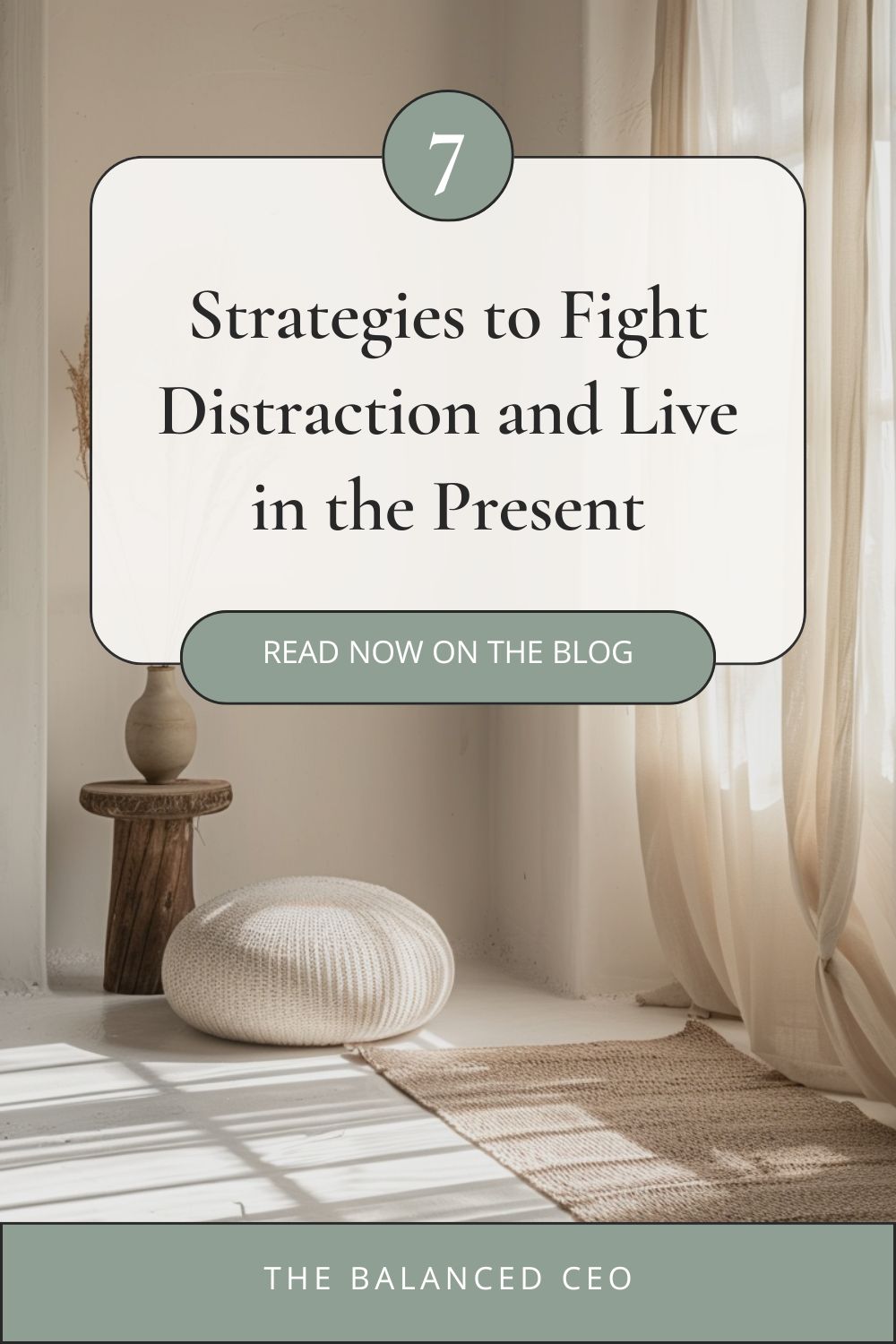This post may contain affiliate links, which means I’ll receive a commission if you purchase through my links, at no extra cost to you. Please read full disclosure for more information.

Modern life is loud, and between the notifications and to-do lists, you likely have an endless inner monologue that keeps your mind spinning. If you’re tired of juggling 10 thoughts at once, it may be time to become more grounded in your day. These seven strategies can help you push back against distractions so you can be fully present in each moment and enjoy living again.
1. Name What Drains Your Attention
When your attention and awareness drop, it might be because you haven’t faced your problem yet. Identifying what’s holding you back or causing you to fail at your priorities is the first step to building a more aware life.
Distractions sneak under the radar, like scrolling through Instagram while pretending to work, daydreaming during conversations or replaying past awkward moments like a personal blooper reel. Start by labeling these intrusions instead of engaging in them.
Next time your mind wanders, say to yourself, “I am distracted by [insert name of thing].” For example, if you’ve been spinning your wheels and not getting stuff done, an unsent email may have flustered you. Once you’ve named the distraction, you can separate yourself from it and deal with it later.
You don’t have to drop everything to try and beat that preoccupation into submission, though. Instead, just name it and become aware of its presence. That awareness can return you to a more present state and let you focus on what you need to.
2. Create a Brain Anchor
When you feel emotional or upset, it’s easy to start chasing thoughts like squirrels on caffeine. Wandering thoughts and a lack of focus are a stormy sea, and your brain needs an anchor to draw you back onto course. This is a mental state you can turn to when you feel upset or mentally disheveled.
To do it, try breath counting. Inhale and count to four. Hold that breath without effort, then exhale the breath for another four counts. Pause for a four-count in a breathless moment, secure in the knowledge that another breath is coming before you inhale for four seconds again. Repeat as many times as you need.
3. Step Away When You Need To
If you find yourself getting distracted at work or can’t focus when you need to get things done at home, try stepping away. Get up and physically leave the space, whether it be your cubicle or your home office. Picking up your phone while you’re in your workspace will only lead you to further distractions.
Taking a break has been shown to improve productivity and restore focus. You can make it effective by setting a timer to mark when you will go back to work. Until then, try to move around, clear your mind of any wandering thoughts and do something energizing, like eating a healthy snack or stretching.
4. Take a Digital Detox
While on the topic of scrolling, a distracted mind often latches onto random thoughts. You likely “enjoy” endless social feeds, even on topics you have no interest in. It’s time to cut back on some screen time and detox your mind from a harmful habit like social media addiction.
Set a goal, start small and remove digital distractions from your life. Perhaps it could be not going online for anything other than work for a day, or if you’re brave, aim for two or three days. Be serious about it — consider logging out of your social media accounts for those two or three days. Find a healthier habit to replace it with, such as reading or writing in your reclaimed time.
5. Start the Day With Intention
If you’re already saying that you no longer make plans because the day never goes as you want it to, this one is for you. How you start your day sets the tone for the rest of it. If your home is a jungle of kids, breakfasts, unpacked lunches and work documents, you need to sit down, identify the obstacles and find ways to keep them in their lane.
Pack lunches the previous night, and ensure you place work documents in your briefcase as soon as you’re done with them. Tidy up before bed, set out your next day’s clothes and decide how you’d like to start the day in an ideal world.
Do you want to have more mindfulness? Wake up earlier and have a cup of tea while you write in your journal. If you desire more energy in the morning, start with a quick set of reps with some light weights or a few minutes on the treadmill. This is mindfulness time, not “mind-full-mess” time. So when outside thoughts and worries intrude on your morning routine, name the invading energy and move on.
Combine this naming activity with the power of positive affirmations. Perhaps your distraction energy is “kids screaming about who goes in the car with mom or dad.” You can counter it with an affirmation like, “I remain calm when others express their feelings.”
6. Rebuild Your Proprioception
Are you, without meaning to, breaking pencils, walking into objects, losing your balance and accidentally hitting your hand in the car door? You may be experiencing proprioception — a dissociation from your body systems due to fatigue and stress. The result is that your body doesn’t know its position in relation to the world around it. Stumbling, feeling dizzy and scraping on surfaces may also indicate you have lost touch with your body.
While you need specialized exercises if your condition is neurological, you can do a mindfulness exercise that lets you gently regain control of your physical self. A meditative body scan, like a mental X-ray, focuses on each body part, from your head to your toes. It can help you reconnect, stimulate nerves and jump back in the driver’s seat. Studies have found that meditation increases your brain’s connectivity for enhanced focus and mental clarity, which lets you process mental and worldly interruptions better.
Connecting with your body also helps you place yourself in the world around you. Combine this with balancing exercises in nature. Take your shoes off and enjoy the goodness of the earth’s energies soaking into your bare feet, helping you align your body and mind.
7. Keep a Thought Journal
When stress or anxiety eats at you, it’s important to slow your thinking and close out all the frozen tabs you have open in your brain. Journaling is the relaxation space where this can safely happen. Most likely, you’ve been stumbling over the clutter of repetitive thinking, so take your mental broom and sweep the jumbled heap onto the page when you journal.
It’s not about solving anything or getting closure on these thoughts. Instead, you want to park them for a bit so you can refocus on the daily activities that need immediate attention. Those issues or challenges are still there, and if you have time later, you can address them. But for now, you just want to focus on getting clear headspace and better mental presence.
Be Equipped to Enjoy Distraction-Free Living
A life filled with random thoughts, harmful habits and routines that wreck your energy challenges your ability to focus on the here and now. However, you can regain control and peace in your day using these seven strategies.

Cora Gold
Contributor
Cora Gold is the Editor-in-Chief of Revivalist magazine, a publication dedicated to happy, healthy, and mindful living.





Leave a Reply